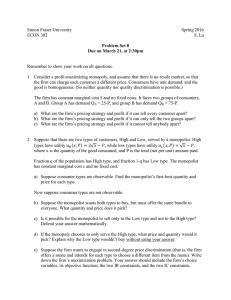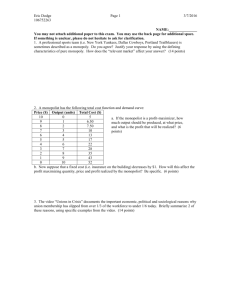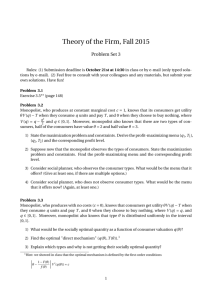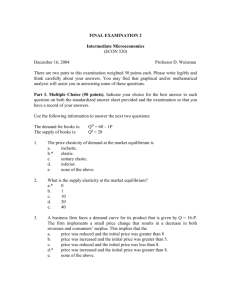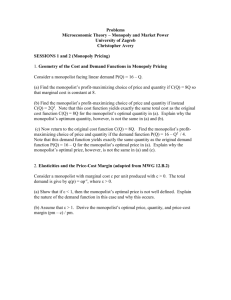Final question - Yiqian Lu 陆奕骞
advertisement
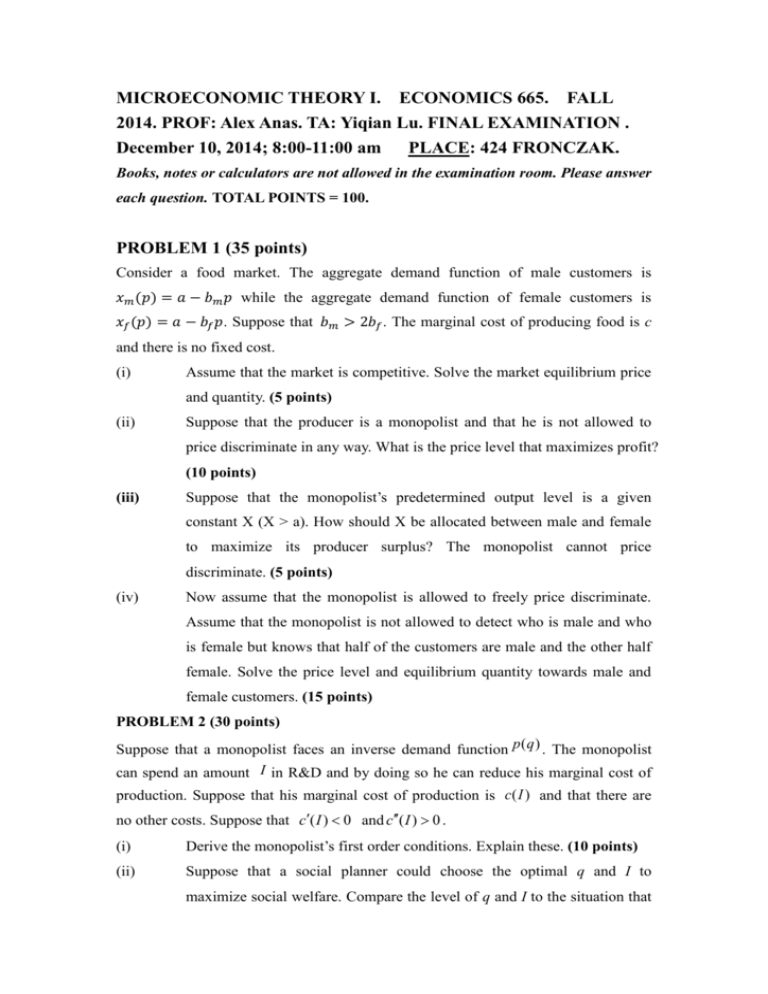
MICROECONOMIC THEORY I. ECONOMICS 665. FALL 2014. PROF: Alex Anas. TA: Yiqian Lu. FINAL EXAMINATION . December 10, 2014; 8:00-11:00 am PLACE: 424 FRONCZAK. Books, notes or calculators are not allowed in the examination room. Please answer each question. TOTAL POINTS = 100. PROBLEM 1 (35 points) Consider a food market. The aggregate demand function of male customers is 𝑥𝑚 (𝑝) = 𝑎 − 𝑏𝑚 𝑝 while the aggregate demand function of female customers is 𝑥𝑓 (𝑝) = 𝑎 − 𝑏𝑓 𝑝. Suppose that 𝑏𝑚 > 2𝑏𝑓 . The marginal cost of producing food is c and there is no fixed cost. (i) Assume that the market is competitive. Solve the market equilibrium price and quantity. (5 points) (ii) Suppose that the producer is a monopolist and that he is not allowed to price discriminate in any way. What is the price level that maximizes profit? (10 points) (iii) Suppose that the monopolist’s predetermined output level is a given constant X (X > a). How should X be allocated between male and female to maximize its producer surplus? The monopolist cannot price discriminate. (5 points) (iv) Now assume that the monopolist is allowed to freely price discriminate. Assume that the monopolist is not allowed to detect who is male and who is female but knows that half of the customers are male and the other half female. Solve the price level and equilibrium quantity towards male and female customers. (15 points) PROBLEM 2 (30 points) Suppose that a monopolist faces an inverse demand function p ( q ) . The monopolist can spend an amount I in R&D and by doing so he can reduce his marginal cost of production. Suppose that his marginal cost of production is c ( I ) and that there are no other costs. Suppose that c( I ) 0 and c( I ) 0 . (i) Derive the monopolist’s first order conditions. Explain these. (10 points) (ii) Suppose that a social planner could choose the optimal q and I to maximize social welfare. Compare the level of q and I to the situation that a social planner does not exists. You must first write the social welfare expression from the given information. (10 points) (iii) Now suppose that the social planner could only choose the optimal level of I to maximize social welfare. But the q is decided by the monopolist after I is chosen by the social planner. Compare the levels of I in this part to the situation that a social planner does not exist. (10 points) PROBLEM 3 (35 points) Two persons decide how fast they should drive on a road on which they are traveling at the same time. Person i chooses speed 𝑥𝑖 and gains 𝑟𝑖 (𝑥𝑖 ), 𝑖 = 1,2. Suppose that 𝑟′𝑖 (𝑥𝑖 )>0 and 𝑟′′𝑖 (𝑥𝑖 )<0, 𝑖 = 1,2. 𝑃(𝑥1 , 𝑥2 ) denotes probability of an accident where the first derivatives are 𝑃𝑥1 (𝑥1 , 𝑥2 ) , 𝑃𝑥2 (𝑥1 , 𝑥2 ) > 0 and all second derivatives are also positive. If an accident happens both persons are hurt and person i suffers a loss 𝑐𝑖 . Driver i’s expected net benefit (ENB) is as follows: ENBi ri ( xi ) ci P( x1 , x2 ) ri ( xi ) 1 P( x1 , x2 ) ri ( xi ) ci P( x1 , x2 ) (i) If the two persons individually decide how fast they should drive, mimicking the Cournot assumptions and each caring only about their own expected net benefit, derive the equations of how they make decisions. Denote the equilibrium speed levels in this part as x1∗ and x2∗ . (5 points) (ii) If the two persons jointly decide (as in a Cartel) how fast each of them should drive to maximize social welfare, derive the equations of how they make that decision. Denote the optimal speed levels in this part as x1∗∗ and x2∗∗ (10 points) (iii) Prove that the speed of each person in (ii) is slower than in (i). (10 points) (iv) Suppose that each person in (i) knows that if they get into an accident, then they will have to pay a fine such that person i pays an amount t i , i=1,2. What are levels of these fines to reduce both drivers' speeds to the level in (ii)? Explain your answer and interpret these fines. (10 points)
